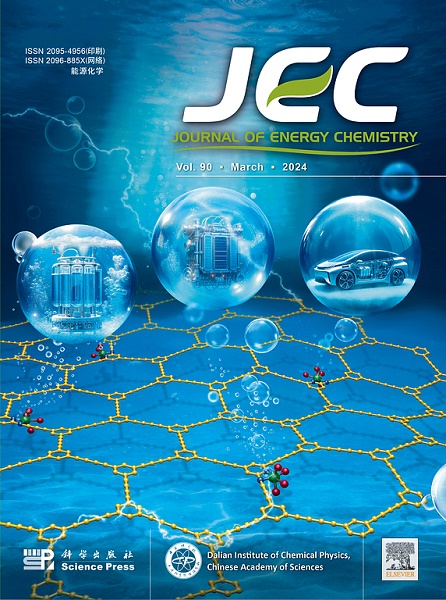Design strategies for enhancing the synthesis of C3+ products from electrochemical CO2 reduction
IF 13.1
1区 化学
Q1 Energy
引用次数: 0
Abstract
The electrochemical CO2 reduction reaction (eCO2RR) offers significant potential for closing the anthropogenic carbon cycle while simultaneously enabling the storage of intermittent sustainable energy. The synthesis of C3+ products from eCO2RR is particularly appealing due to their higher commercial value compared to C1 or C2 compounds, and their crucial roles as high-energy-density fuels or feedstocks for a wide range of industrial applications. This encourages us to summarize recent notable progress in enhancing C3+ production. This review starts from the formation pathways of C3+ products by delving into key intermediates and *C–*C coupling reactions for mechanistic investigations. Subsequently, we discuss the representative eCO2RR electrocatalysts for C3+ synthesis, including Cu and non-Cu catalysts, highlighting typical design strategies for markedly promoting the catalytic performance or expanding the range of products. Additionally, we also emphasize system upgrading strategies, covering manipulation of electrolysis conditions, microenvironment regulation, and cascade catalysis, for facilitating C3+ production. We finally end with future directions in this rapidly advancing field. By elucidating the formation mechanisms, catalyst design principles, and system upgrading strategies, this review is expected to draw significant attention to C3+ products and stimulate further research into developing advanced catalytic systems for their efficient synthesis.
提高CO2电化学还原合成C3+产物的设计策略
电化学CO2还原反应(eCO2RR)为关闭人为碳循环提供了巨大的潜力,同时实现了间歇性可持续能源的储存。与C1或C2化合物相比,eCO2RR合成C3+产品尤其具有吸引力,因为它们具有更高的商业价值,并且它们作为高能量密度燃料或广泛工业应用的原料具有重要作用。这鼓励我们总结最近在提高C3+产量方面取得的显著进展。本文从C3+产物的形成途径入手,深入研究了关键中间体和*C - *C偶联反应的机理。随后,我们讨论了具有代表性的用于C3+合成的eCO2RR电催化剂,包括Cu和非Cu催化剂,重点介绍了显著提高催化性能或扩大产品范围的典型设计策略。此外,我们还强调了系统升级策略,包括电解条件的操纵,微环境调节和级联催化,以促进C3+的生产。我们最后以这个快速发展的领域的未来方向结束。通过阐明C3+的形成机制、催化剂设计原则和系统升级策略,本文将引起人们对C3+产品的重视,并进一步研究开发先进的催化体系,以实现其高效合成。
本文章由计算机程序翻译,如有差异,请以英文原文为准。
求助全文
约1分钟内获得全文
求助全文
来源期刊

Journal of Energy Chemistry
CHEMISTRY, APPLIED-CHEMISTRY, PHYSICAL
CiteScore
19.10
自引率
8.40%
发文量
3631
审稿时长
15 days
期刊介绍:
The Journal of Energy Chemistry, the official publication of Science Press and the Dalian Institute of Chemical Physics, Chinese Academy of Sciences, serves as a platform for reporting creative research and innovative applications in energy chemistry. It mainly reports on creative researches and innovative applications of chemical conversions of fossil energy, carbon dioxide, electrochemical energy and hydrogen energy, as well as the conversions of biomass and solar energy related with chemical issues to promote academic exchanges in the field of energy chemistry and to accelerate the exploration, research and development of energy science and technologies.
This journal focuses on original research papers covering various topics within energy chemistry worldwide, including:
Optimized utilization of fossil energy
Hydrogen energy
Conversion and storage of electrochemical energy
Capture, storage, and chemical conversion of carbon dioxide
Materials and nanotechnologies for energy conversion and storage
Chemistry in biomass conversion
Chemistry in the utilization of solar energy
 求助内容:
求助内容: 应助结果提醒方式:
应助结果提醒方式:


